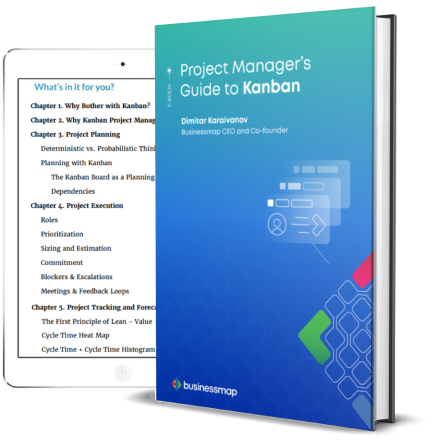Key Takeaways
-
What is Value Stream Mapping (VSM)? A Lean tool to visualize and improve the flow of materials, information, and work through a process.
-
Main Goal: Identify and remove waste, improve efficiency, and boost value delivery.
-
Four Core Steps: Map current state, analyze for waste, design future state, and implement improvements.
-
Industries Using VSM: Manufacturing, healthcare, software, procurement, and more.
What Is Value Stream Mapping (VSM)?
Value stream mapping (VSM) is a Lean management technique that visualizes the flow of materials, information, and work required to deliver a product or service. Originally popularized by Toyota, it's now widely used beyond manufacturing in fields like IT, healthcare, logistics, and services. The technique is also part of the Six Sigma and Lean Six Sigma methodologies for process improvement.
VSM provides a bird's eye view of the entire process, highlighting both value-adding and non-value-adding activities (waste). By mapping out this flow, organizations can identify bottlenecks, inefficiencies, and waste that impact performance.
What Are the Four Steps of Value Stream Mapping?
-
Map the Current State: Understand how things work today.
-
Identify Waste and Inefficiencies: Look for delays, redundancies, and non-value-added steps.
-
Design the Future State: Visualize how things should work.
-
Implement and Improve: Create an action plan, implement changes, and revisit periodically.
What Are the Core Components of VSM?
-
Process steps: All tasks from start to finish.
-
Information flow: How data moves through the process.
-
Timeline metrics: Lead time, cycle time, WIP.
How VSM Helps Identify and Eliminate Waste
By visualizing the flow and timelines, VSM highlights:
- Delays in handoffs
- Rework or overprocessing
- Unused inventory
- Communication gaps
These insights enable organizations to apply Lean techniques to eliminate or reduce these inefficiencies.
10 Years Kanban Experience In 1 Free Book.
Project Manager's Guide to Kanban
How to Create a Value Stream Map (VSM) Using Kanban
Kanban is one of the most reliable tools for value stream mapping. Especially if you want to visualize a knowledge work process. It is very intuitive to work with and allows for easy changes.
1. Build a Kanban Board
Start simple: Requested → In Progress → Done. Create a Kanban board, preferably for a single team or department, to track tasks effectively.
 Example of a basic Kanban board
Example of a basic Kanban board
2. Define Workflow Steps
Break down "In Progress" into value-adding steps.
Your goal is to break down "In Progress" areas into multiple columns representing your workflow’s most crucial value stream steps. A typical software development process includes the following steps: Technical Design, Coding, Testing, and Code Review. The "In Progress" area of a procurement team process, for instance, might include the following stages: Request for Quotation, Waiting, and Purchase Order.
 A procurement process mapped using a Kanban board
A procurement process mapped using a Kanban board
3. Identify Queues and Bottlenecks
Spot delays and waiting stages.
More precise mapping will provide a more comprehensive view and, therefore, offer more indications of where you can improve your performance.
 Mapping an entire end-to-end value delivery flow
Mapping an entire end-to-end value delivery flow
4. Measure Key Metrics
Select a range of performance metrics to monitor. A simple set of workflow key performance indicators is:
- Lead time
- Cycle time
- Throughput
- Work in Progress (WIP)
 Monitoring key process metrics using the "Workflow Performance Summary" widget in Businessmap
Monitoring key process metrics using the "Workflow Performance Summary" widget in Businessmap
Value management tools like Businessmap or Targetprocess offer visual dashboards, widgets, and automation to support this process.
What Is a Value Stream Mapping Template?
A value stream mapping template is a simple visual tool that helps you map out your workflow, spot inefficiencies, and plan improvements. With AI-powered tools, you can create one in seconds and turn ideas into real projects across your teams.
Common Mistakes to Avoid When Using VSM
-
Skipping metrics: Without data, improvements are just guesses.
-
Not involving teams: Siloed efforts miss hidden inefficiencies.
-
Overcomplicating maps: Start simple and gradually build up the detail.
-
Ignoring the future-state map: Don't stop at analysis. Redesign the ideal workflow.
Value Stream Mapping Across Industries: Practical Examples
VSM isn’t just for manufacturing - it delivers results in various fields:
-
Service industries: In banking, insurance, or procurement, VSM helps map workflows and expose inefficiencies, such as redundant steps or long wait times for approvals. Streamlining these can improve turnaround time and customer satisfaction.
-
Pharma and healthcare: Mapping the patient journey reveals critical delays or inefficiencies. VSM can help reduce waiting times, enhance staff productivity, and improve patient outcomes.
-
Logistics and supply chain: Identifying overstock, transport delays, or process silos through VSM leads to better operational control, smoother workflows, and lower costs.
How Companies Use VSM to Drive Measurable Efficiency Gains
Tackling Inefficiency in Global Purchasing
Encoparts®, a global supplier of machinery spare parts, faced major inefficiencies in its international purchasing workflow. Using value stream mapping and the Businessmap platform, they identified critical areas of waste, including excessive waiting time, overprocessing, and poor communication.
By combining VSM and Kanban, they built a digital, transparent process that enabled:
-
33% improvement in process efficiency
-
Real-time metrics to manage cycle time, throughput, and WIP
-
Better coordination across departments and suppliers
»» Explore the Encoparts case study
Achieving 54% Faster Cycle Time with VSM and Kanban
AK Gida, the largest dairy product manufacturer in Turkey (part of the Group Lactalis), utilized Businessmap's platform to spearhead a Lean/Agile transformation in its IT department. After applying VSM and Kanban boards, they uncovered hidden inefficiencies in their request handling, delivery, and collaboration with external vendors.
Key results:
-
54% cycle time improvement and 23% lead time reduction
-
21% faster resolution of external vendor blockers
-
Complete work transparency across all organizational levels
Their hybrid approach - combining upstream Kanban with Scrum for execution - brought end-to-end visibility and enabled ongoing process optimization. By using Businessmap's analytics tools (like Cycle Time Scatterplot and Blocker Clustering), the company now manages work dependencies and sets reliable Service Level Expectations (SLEs) across teams.
»» Read the AK Gida case study
FAQs
Q: Are there value stream mapping templates?
Most digital tools, such as Businessmap and Miro, offer pre-built templates or AI-generated templates, including ones for VSM.
Q: How to create a current and future state map?
Start with current workflows and metrics. Involve the team to ideate improvements, then visualize and simulate the desired future state.
Q: How is VSM different from process mapping?
Process mapping shows sequential tasks but often misses delays or data flow. VSM, on the other hand, includes time metrics and waste, giving a more complete picture of flow efficiency.
Q: How do you measure ROI from VSM initiatives?
Use measurable outcomes such as:
- Reduced lead/cycle time
- Fewer defects or delays
- Higher throughput
- Improved customer satisfaction
Businessmap's Workflow Performance Summary can help quantify these results over time.
Q: What are the best VSM software tools?
- Businessmap: Visual workflows, metrics, collaboration.
- Miro: Flexible diagramming.
- Lucidchart: Great for general process mapping.
Tip: Look for tools that support integration, templates, and custom metrics.
Businessmap is the most flexible software
to align work with company goals






 Example of a basic Kanban board
Example of a basic Kanban board A procurement process mapped using a Kanban board
A procurement process mapped using a Kanban board Mapping an entire end-to-end value delivery flow
Mapping an entire end-to-end value delivery flow Monitoring key process metrics using the "Workflow Performance Summary" widget in Businessmap
Monitoring key process metrics using the "Workflow Performance Summary" widget in Businessmap


